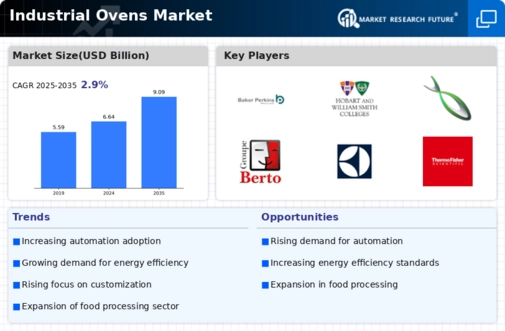Rising Demand in Food Processing
The Industrial Ovens Market is experiencing a notable surge in demand, particularly within the food processing sector. As consumer preferences shift towards convenience foods and ready-to-eat meals, manufacturers are increasingly investing in advanced industrial ovens to enhance production efficiency. The food processing industry is projected to grow at a compound annual growth rate of approximately 5.5% over the next few years, driving the need for high-capacity ovens that can meet stringent quality and safety standards. This trend indicates that companies are prioritizing the integration of innovative technologies in their production lines, thereby propelling the Industrial Ovens Market forward. Furthermore, the emphasis on maintaining food quality and safety is likely to further stimulate investments in advanced oven technologies.
Increased Focus on Energy Efficiency
Energy efficiency has emerged as a critical driver within the Industrial Ovens Market. As energy costs continue to rise, manufacturers are increasingly seeking ovens that minimize energy consumption while maximizing output. The demand for energy-efficient industrial ovens is projected to grow by approximately 5% annually, as companies aim to reduce operational costs and enhance sustainability. This focus on energy efficiency is not only economically beneficial but also aligns with global sustainability goals. Consequently, manufacturers are investing in advanced technologies that optimize energy use, thereby contributing to the overall growth of the Industrial Ovens Market. The integration of energy-efficient designs is likely to become a standard expectation among consumers, further propelling market expansion.
Technological Innovations in Oven Design
Technological advancements are playing a pivotal role in shaping the Industrial Ovens Market. Innovations such as energy-efficient designs, automation, and smart technology integration are becoming increasingly prevalent. For instance, the introduction of IoT-enabled ovens allows for real-time monitoring and control, enhancing operational efficiency. The market for smart industrial ovens is expected to grow at a rate of 6% annually, reflecting the industry's shift towards more sophisticated solutions. These innovations not only improve energy consumption but also enhance the overall performance of industrial ovens, making them more appealing to manufacturers across various sectors. As companies strive to remain competitive, the adoption of these advanced technologies is likely to drive growth in the Industrial Ovens Market.
Growth in Automotive and Aerospace Sectors
The Industrial Ovens Market is significantly influenced by the expansion of the automotive and aerospace sectors. These industries require specialized ovens for processes such as curing, drying, and heat treatment of components. The automotive sector, in particular, is projected to witness a growth rate of around 4% annually, which is expected to drive the demand for industrial ovens tailored for automotive applications. Similarly, the aerospace industry is increasingly adopting advanced manufacturing techniques, necessitating the use of high-performance ovens. This growth in both sectors suggests a robust future for the Industrial Ovens Market, as manufacturers seek to optimize production processes and ensure compliance with industry standards.
Regulatory Compliance and Safety Standards
The Industrial Ovens Market is also being shaped by stringent regulatory compliance and safety standards. Industries such as food processing, pharmaceuticals, and manufacturing are subject to rigorous regulations that dictate the operational parameters of industrial ovens. Compliance with these standards is essential for ensuring product safety and quality, which in turn drives the demand for advanced oven technologies. As regulations evolve, manufacturers are compelled to invest in ovens that not only meet current standards but also anticipate future requirements. This trend indicates a growing market for industrial ovens that are designed with compliance in mind, thereby fostering growth within the Industrial Ovens Market.
























